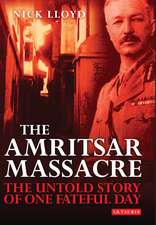Transnational Fascism in the Twentieth Century: Spain, Italy and the Global Neo-Fascist Network: A Modern History of Politics and Violence
Autor Dr Matteo Albanese, Dr Pablo del Hierroen Limba Engleză Paperback – 21 mar 2018
| Toate formatele și edițiile | Preț | Express |
|---|---|---|
| Paperback (1) | 237.28 lei 6-8 săpt. | |
| Bloomsbury Publishing – 21 mar 2018 | 237.28 lei 6-8 săpt. | |
| Hardback (1) | 772.98 lei 6-8 săpt. | |
| Bloomsbury Publishing – 21 sep 2016 | 772.98 lei 6-8 săpt. |
Preț: 237.28 lei
Nou
Puncte Express: 356
Preț estimativ în valută:
45.42€ • 47.72$ • 38.17£
45.42€ • 47.72$ • 38.17£
Carte tipărită la comandă
Livrare economică 12-26 martie
Preluare comenzi: 021 569.72.76
Specificații
ISBN-13: 9781350063846
ISBN-10: 1350063843
Pagini: 240
Dimensiuni: 156 x 234 x 18 mm
Greutate: 0.34 kg
Ediția:NIPPOD
Editura: Bloomsbury Publishing
Colecția Bloomsbury Academic
Seria A Modern History of Politics and Violence
Locul publicării:London, United Kingdom
ISBN-10: 1350063843
Pagini: 240
Dimensiuni: 156 x 234 x 18 mm
Greutate: 0.34 kg
Ediția:NIPPOD
Editura: Bloomsbury Publishing
Colecția Bloomsbury Academic
Seria A Modern History of Politics and Violence
Locul publicării:London, United Kingdom
Caracteristici
Consideration of Spanish-Italian fascism and global links is representative of an increasingly popular transnational approach
Notă biografică
Matteo Albanese is Fellow at the Institute of Social Sciences at the University of Lisbon, Portugal. Pablo del Hierro is Assistant Professor of European History at the University of Maastricht, The Netherlands.
Cuprins
Introduction1. The Origins of the Fascist Network, 1922-19452. The Efforts to Keep the Network Alive After the War, 1945-19563. Transition for the Transnational Network, 1956-19604. A Progressive Radicalization, 1960-19685. The Adoption of a Terrorist Strategy, 1968-1982BibliographyIndex
Recenzii
A well-conceived and immensely readable book. It deserves a place on the reading lists of courses on the History of Europe in the twentieth century. It is also an engaging book that will hold the attention of any reader interested in the history of the twentieth century.
[The authors] break new ground in treating both the "classic" period, when fascism was in power in Italy, and the decades following World War II.
This is a pioneering study which casts a great deal more light on the 'Italo-Spanish node' of the international fascist network than previous works. In particular, the authors demonstrate very clearly how and why the relationship between Italian and Spanish fascism which was established in the 1920s and consolidated during the Spanish Civil War, survived the defeat of the Axis in 1945. Indeed, the greatest strength of the book is precisely the attention which it devotes to the changing relationship between Italian neo-fascists and the Franco regime between 1945 and latter's demise 30 years later. It also explains the circumstances in which the cooperation between the Spanish extreme right and the Italian neo-fascist terrorists came to an end. An extremely useful contribution of the history of fascism.
This important book examines the nature of relationships between Italian and Spanish fascists and the Franco regime. It focuses not just on the 1930s and 1940s but most importantly on the significance of Franco's Spanish dictatorship, the Catholic Church and other European fascists on the continuation of these relationships after 1945. Albanese and del Hierro are to commended for their detailed research and significant insight on fascism's survival and continuing influence on Europe in the twentieth century.
[The authors] break new ground in treating both the "classic" period, when fascism was in power in Italy, and the decades following World War II.
This is a pioneering study which casts a great deal more light on the 'Italo-Spanish node' of the international fascist network than previous works. In particular, the authors demonstrate very clearly how and why the relationship between Italian and Spanish fascism which was established in the 1920s and consolidated during the Spanish Civil War, survived the defeat of the Axis in 1945. Indeed, the greatest strength of the book is precisely the attention which it devotes to the changing relationship between Italian neo-fascists and the Franco regime between 1945 and latter's demise 30 years later. It also explains the circumstances in which the cooperation between the Spanish extreme right and the Italian neo-fascist terrorists came to an end. An extremely useful contribution of the history of fascism.
This important book examines the nature of relationships between Italian and Spanish fascists and the Franco regime. It focuses not just on the 1930s and 1940s but most importantly on the significance of Franco's Spanish dictatorship, the Catholic Church and other European fascists on the continuation of these relationships after 1945. Albanese and del Hierro are to commended for their detailed research and significant insight on fascism's survival and continuing influence on Europe in the twentieth century.
























